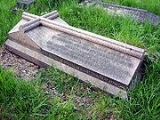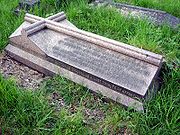
Sydney Cotton
Encyclopedia
Lieutenant-General Sir Sydney John Cotton GCB
(2 December 1792 – 19 February 1874) was a British Army
officer.
, Oxfordshire
, England, and his wife Matilda, daughter and heiress of John Lockwood of Dews Hall, Essex
.
He joined the British Army in 1810 as a Cornet in the 22nd Light Dragoons
. He served extensively in Australia
(1835–42) and India
(1810-35 & 1842-1863, including service throughout the Indian Mutiny of 1857-58).
For his frontier services Cotton was made KCB
and after returning to England he was appointed Lieutenant-General in 1866 and GCB
in 1872. In 1868 in London he had published "Nine Years on the North-West Frontier of India, from 1854 to 1863".
He was Governor of the Royal Hospital Chelsea
from 1872 until 1874.
 He is buried in Brompton Cemetery
He is buried in Brompton Cemetery
, London
.
Mount Cotton, Queensland
is named after him.
Order of the Bath
The Most Honourable Order of the Bath is a British order of chivalry founded by George I on 18 May 1725. The name derives from the elaborate mediæval ceremony for creating a knight, which involved bathing as one of its elements. The knights so created were known as Knights of the Bath...
(2 December 1792 – 19 February 1874) was a British Army
British Army
The British Army is the land warfare branch of Her Majesty's Armed Forces in the United Kingdom. It came into being with the unification of the Kingdom of England and Scotland into the Kingdom of Great Britain in 1707. The new British Army incorporated Regiments that had already existed in England...
officer.
Military career
He was the second son of Henry Calveley Cotton of WoodcoteWoodcote
Woodcote is a village in the civil parish in South Oxfordshire, about southeast of Wallingford and about northwest of Reading, Berkshire. It is in the Chiltern Hills, and the highest part of the village is above sea level....
, Oxfordshire
Oxfordshire
Oxfordshire is a county in the South East region of England, bordering on Warwickshire and Northamptonshire , Buckinghamshire , Berkshire , Wiltshire and Gloucestershire ....
, England, and his wife Matilda, daughter and heiress of John Lockwood of Dews Hall, Essex
Essex
Essex is a ceremonial and non-metropolitan county in the East region of England, and one of the home counties. It is located to the northeast of Greater London. It borders with Cambridgeshire and Suffolk to the north, Hertfordshire to the west, Kent to the South and London to the south west...
.
He joined the British Army in 1810 as a Cornet in the 22nd Light Dragoons
22nd Dragoons
The 22nd Dragoons was the title held by a series of four Cavalry regiments of the British Army raised and disbanded between 1716 and 1945. The last regiment of this name existed during the Second World War, from 1 December 1940 until 30 November 1945....
. He served extensively in Australia
Australia
Australia , officially the Commonwealth of Australia, is a country in the Southern Hemisphere comprising the mainland of the Australian continent, the island of Tasmania, and numerous smaller islands in the Indian and Pacific Oceans. It is the world's sixth-largest country by total area...
(1835–42) and India
India
India , officially the Republic of India , is a country in South Asia. It is the seventh-largest country by geographical area, the second-most populous country with over 1.2 billion people, and the most populous democracy in the world...
(1810-35 & 1842-1863, including service throughout the Indian Mutiny of 1857-58).
For his frontier services Cotton was made KCB
Order of the Bath
The Most Honourable Order of the Bath is a British order of chivalry founded by George I on 18 May 1725. The name derives from the elaborate mediæval ceremony for creating a knight, which involved bathing as one of its elements. The knights so created were known as Knights of the Bath...
and after returning to England he was appointed Lieutenant-General in 1866 and GCB
Order of the Bath
The Most Honourable Order of the Bath is a British order of chivalry founded by George I on 18 May 1725. The name derives from the elaborate mediæval ceremony for creating a knight, which involved bathing as one of its elements. The knights so created were known as Knights of the Bath...
in 1872. In 1868 in London he had published "Nine Years on the North-West Frontier of India, from 1854 to 1863".
He was Governor of the Royal Hospital Chelsea
Royal Hospital Chelsea
The Royal Hospital Chelsea is a retirement home and nursing home for British soldiers who are unfit for further duty due to injury or old age, located in the Chelsea region of central London, now the Royal Borough of Kensington and Chelsea. It is a true hospital in the original sense of the word,...
from 1872 until 1874.

Brompton Cemetery
Brompton Cemetery is located near Earl's Court in South West London, England . It is managed by The Royal Parks and is one of the Magnificent Seven...
, London
London
London is the capital city of :England and the :United Kingdom, the largest metropolitan area in the United Kingdom, and the largest urban zone in the European Union by most measures. Located on the River Thames, London has been a major settlement for two millennia, its history going back to its...
.
Mount Cotton, Queensland
Mount Cotton, Queensland
Mount Cotton is a suburb located south-east of Brisbane, Queensland, Australia in the Redland City local government area.Mount Cotton is named for the mountain that is in the area. It was named by Robert Dixon, a surveyor in the colony of Queensland. He named it after the commandant of the penal...
is named after him.
See also
- Rev. Richard Lynch CottonRichard Lynch CottonRev. Richard Lynch Cotton was a British vicar and academic administrator at the University of Oxford.Cotton was born in Whitchurch, Oxfordshire, the son of Henry Calveley Cotton and Matilda Lockwood, one of 11 children .He was educated at Charterhouse School and Worcester College, Oxford, where he...
(1794–1880), younger brother - Sir Arthur Thomas Cotton (1803–1899), younger brother

